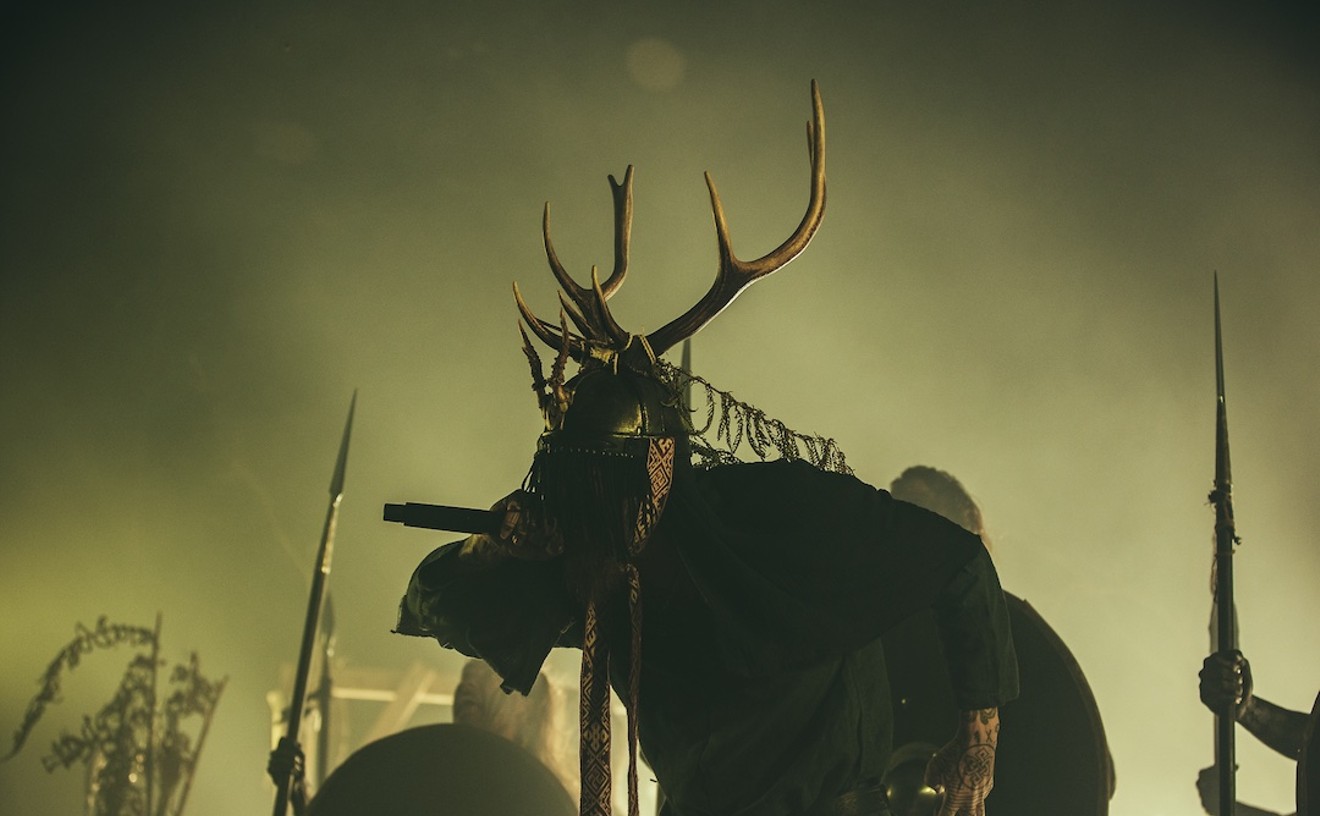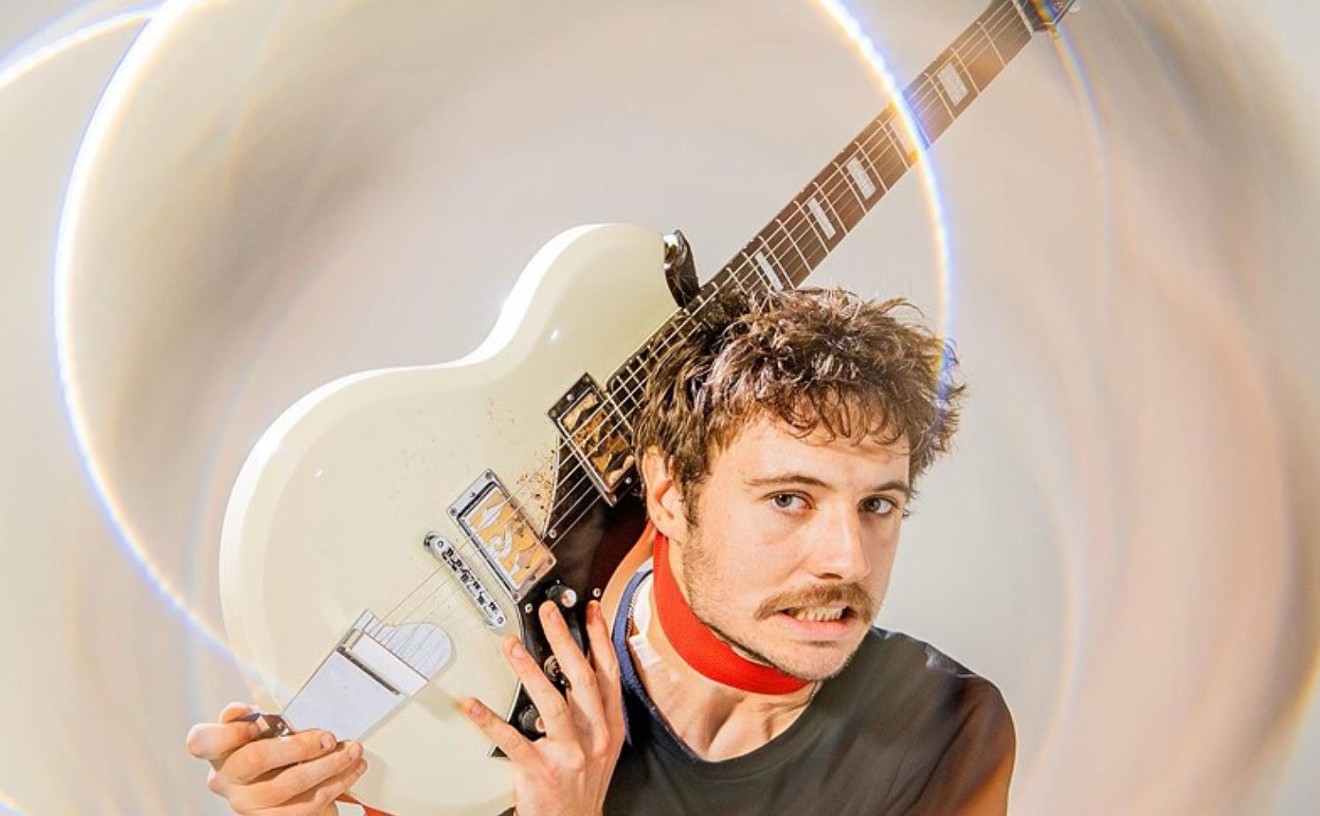When Rathbun speaks of finding new instruments, however, what he really means is hammering, welding and otherwise assembling them by hand. Besides playing bass in the Oakland-based art-rock ensemble, he's also the group's chief instrument builder. But as forward-thinking as that may sound, this Museum's curators looked to the past for inspiration, to a time, nearly a hundred years ago, when a ragtag crew of Italians turned noise into art.
Just after the turn of the last century, a group of pesky upstarts who called themselves the Futurists decided that poetry, art and music had become idle playthings of the rich and unimaginative. The Futurists attacked what they viewed as useless admiration of the past and saw museums as graveyards. They embraced speed, noise, machines and pollution. They wrote endless manifestos on everything from dance and architecture to language and lust. While notorious composer/anarchist Luigi Russolo championed the art of noise, the movement's poster boy, Filippo Tommaso Marinetti, had the audacity -- mamma mia! -- to glorify war as "the sole hygiene."
Trampling one's ancestors, it would seem, never goes out of style: After World War I killed off the Futurists, copies of Marinetti's manifesto soon inspired none other than the Nazis to fly their freak flag at full mast. As time marched on, the Futurists' utopian ferocity seemed to recycle itself over and over in one form or another. The Black Panthers asserted themselves "by any means necessary." Andy Warhol praised soup cans over landscapes. And Joe Strummer declared that "phony Beatlemania has bitten the dust."
The Futurists' spirit comes full circle with Sleepytime Gorilla Museum. Taking its name from an old factory in Manhattan's meatpacking district that was converted into a printing press and gallery, today's five-member Sleepytime Gorilla Museum bangs out a dark and startling sound. Prog-metal slams headfirst into industrial opera, complete with strings and silly costumes. And for a bunch of overeducated music geeks, they sure make a racket.
"The Futurists' concept of trying to bring in the sounds of the city were pretty influential on Throbbing Gristle and Einstürzende Neubauten, who in turn influenced us in our pursuit of found sounds amplified and shaped," says guitarist Nils Frykdahl.
A former headbanger and classically trained flutist, Frykdahl explored the outer reaches of music and spectacle in Idiot Flesh, with David Shamrock (Acid Rain) and Rathbun, the sound engineer for Polymorph studios. When Flesh disbanded in 1998, Frykdahl and Rathbun enlisted violinist Carla Kihlstedt from a vocal-centered side project called Charming Hostess. As one-third of Tin Hat Trio, Kihlstedt, an in-demand session player who's collaborated with the likes of Tom Waits and Willie Nelson, brought a chamber-minded sensibility to the Museum -- plus a vocal range to match Bjrk's. Drummer Frank Grau, from Species Being, rounded out the rhythm section with industrial-waste percussionist Moe! Staiano (whose unruly, forty-member Moe!kestra! performs unconventional scores with wine glasses, oil drums and air-raid sirens.) After Grau and Staiano left, the Museum acquired the final two pieces of its current lineup: drummer Matthias Bossi (ex-timekeeper for New York's Skeleton Key) and junk banger Michael Mellender, co-founder of the Bay Area's Immersion Composition Society. Along with a spring-nail guitar, slide piano-log and a pressure-cap marimba, the Museum clutters the stage with enough unusual, hand-built gadgetry to make Harry Partch salivate.
"They're all difficult to play, but there's an element of compromise in them, because they're all built to produce brand-new sounds," Rathbun explains. "And you can't just stick them into any old song. Very early in the process, we often try to incorporate a homemade instrument, and that will really guide the process. And that, to some extent, dictates what can be done and what can't."
If the band's 2001 debut, Grand Opening and Closing is any indication, the possibilities of creating elaborate music with primitive sounds are endless -- not that they always make for an easy listening experience, though. Disjointed and sprawling, the densely layered arrangements recall Art Bears, Henry Cow and even local avant-garde outfit Thinking Plague. Challenging to the extreme, the album pays homage to chaos, doomsday and obscure Scottish philosopher John Kane, the founder of black math who believed in a theorem for invisibility. With a booming voice as raw as prison pruno, Frykdahl sings the praises of insomnia ("Sleep Is Wrong") or softens his baritone for a creepy lullaby that ultimately derails into noise and nightmare ("Sleepytime").
But for all its grandiosity, odd time signatures and impressive technicality, is the band too wanky for its own good sometimes?
"Absolutely," Rathbun admits. "It's really easy, when you're educated in music, to stick a bunch of shit in there just because it's interesting musically. You've got to remember that the song has an emotional thrust -- that's the first purpose. I'd be quite happy if people thought of us as being a band that evoked a lot of emotion rather than a band that's just smart."
Kihlstedt agrees, and says the act isn't consciously trying to shift the course of music or thought.
"I think that we all have a personal need to keep the music visceral and still something that the body can relate to, so it motivates you on a physical level and not just on a mental level," she offers. "I grew up playing in Bartók string quartets when I was twelve. But it's too easy of an assumption to say that classical music means not physical and not visceral, because if you take Bartók and listen to that shit, it'll rock your ass off. It's as body-based as anything. Especially where parts are interwoven and each person is responsible for a different part of the beat, and you kind of have to put yourself at the service of a larger group concept of beat and harmony."
Bartók takes a back seat during the Museum's latest effort, Sleepytime Gorilla Museum of Natural History. Another ponderingly complex, text-heavy affair, the followup explores the bestial genealogy between man and the insects. It raises questions about God, the future, the past and why a cockroach would choose to live in the trash instead of the great outdoors. In the album's accompanying pamphlet, there's also a point-by-point debate between various Futurists and the Unabomber.
"They really don't agree on much, except the need for some kind of immediate action," Frykdahl points out. "The Futurists were advocates of technology. They thought, 'Let's drive through the museums and annihilate the past and get all this garbage out of the way.' Kaczynski thought technology was reducing us to helpless, legless, soulless automatons who are essentially slaves to the society that further advances machine life.
"I'm not ready to publicly take a side with either," Frykdahl adds.
Even so, the bellowing frontman (who reserves his more elfin side for an acoustic act called Faun Fables) has no problem using the latest digital gear to capture field recordings -- especially if he can use them to juxtapose the sounds of the Okefenokee Swamp with an ancient tape of Marinetti's nonsense poetry ("Bring Back the Apocalypse"). Sometimes a hidden microphone yields even stranger spoken material: a drunk roughneck in Toledo who slurs on about the merits of "plagiarlism" ("Babydoctor"), or an unidentified Southerner who states that he'd rather keep his knife than lose it in the back of an enemy ("What Will We Do Without Us?").
"We record everybody who comes on the bus," Frykdahl confides, "secretly."
A sound laboratory on wheels, the band's touring coach has crisscrossed America several times, allowing the Museum to document its favorite people, parks and rest stops. And if the members ever play Italy, you can bet they'll make a holy pilgrimage to the birthplace of the Futurists. Then again, getting their gear across the Atlantic and through customs poses a few problems.
"We haven't figured out how to do that," Kihlstedt admits. "Maybe we could send Dan over earlier to rebuild all the instruments and keep 'em there. Then we'd have our European stash."
Either way, the Sleepytimers have come a long way since their first performance at an abandoned Newberry's department store in 1999. The grand unveiling was certainly advertised, but no one was admitted into the show -- except for a single, sexless creature covered in slime.
"We actually did find a banana slug in a park in Oakland and set it up in a fish aquarium on a table at the end of a red carpet," Kihlstedt recalls. "We treated it with as much respect as it deserved. Our primordial invertebrates don't get their due. We just thought it was time to celebrate the creatures who most embodied the essence of where we all emerged from."
So what became of the slug?
"We let it go afterwards," she says. "I'm sure it was very happy. I wouldn't have known how to take care of it."
Sounds like the slug was lucky. Apparently, the Museum had no use for a splatting sound on its new record.










